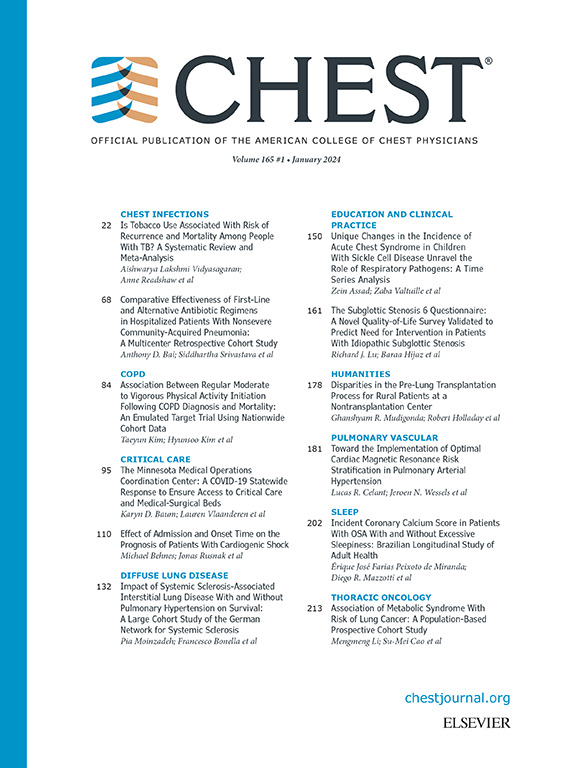机器听力诊断阻塞性睡眠呼吸暂停:贝叶斯荟萃分析。
IF 9.5
1区 医学
Q1 CRITICAL CARE MEDICINE
引用次数: 0
摘要
背景:在全球10亿阻塞性睡眠呼吸暂停(OSA)患者中,90%仍未确诊。他们的主要障碍是夜间多导睡眠图,这需要专门的设备、熟练的技术人员和只有三级睡眠中心才有的住院床位。人工智能(AI)的最新进展使通过呼吸录音检测OSA成为可能。研究问题:诊断的准确性是什么?我们如何优化OSA的机器聆听?研究设计与方法系统检索spubmed、Embase、Scopus、Web of Science和IEEE explore。两名盲法评估者选择了一些研究,比较了使用过夜录音的人工智能方法与使用训练检验分割或k-fold交叉验证的传统诊断方法(呼吸暂停-低通气指数[AHI])的患者水平诊断性能。进行贝叶斯双变量meta分析和meta回归。采用选择模型评估发表偏倚。采用QUADAS-2和GRADE评估偏倚风险和证据质量。结果从6254条记录中,我们纳入了16项研究(41个模型),对4,864/2,370名参与者进行了训练/测试。没有一项研究存在高偏倚风险。机器聆听的总灵敏度(95%可信区间)为90.3%(86.9-93.1%),特异性为86.7%(83.1-89.7%),诊断优势比为60.8(39.4-99.9),阳性似然比为6.78(5.34-8.85),阴性似然比为0.113(0.079-0.152)。在≥5 AHI的否决,≥15日≥30:敏感性为94.3% (90.3 - -96.8%),86.3% (-90.9% - 80.1),86.3% (-91.1% - 79.2);特异性分别为78.5%(68.0 - -86.9%),87.3%(-91.3% - 81.8),89.5%(84.8 -93.3%)。元回归发现,较高的音频采样频率灵敏度较高;非接触式麦克风;OSA患病率较高;训练-检验分裂模型评价。无论是家用智能手机还是实验室专业麦克风录音,准确率都是一样的;深度学习与传统机器学习;不同的年龄和性别。发表偏倚不明显。证据的质量很高。机器听力达到了卓越的诊断准确性,优于STOP-Bang,可与普通的家庭睡眠测试相媲美。数字医学应进一步探索和外部验证,以获得和公平的OSA诊断。本文章由计算机程序翻译,如有差异,请以英文原文为准。
Machine Listening for Obstructive Sleep Apnea Diagnosis: A Bayesian Meta-Analysis.
BACKGROUND
Among 1 billion patients worldwide with obstructive sleep apnea (OSA), 90% remain undiagnosed. Their main barrier is the overnight polysomnogram, which requires specialized equipment, skilled technicians and inpatient beds available only in tertiary sleep centers. Recent advances in artificial intelligence (AI) have enabled OSA detection using breath sound recordings.
RESEARCH QUESTION
What is the diagnostic accuracy and how can we optimize machine listening for OSA?
STUDY DESIGN AND METHODS
PubMed, Embase, Scopus, Web of Science and IEEE Xplore were systematically searched. Two blinded reviewers selected studies comparing the patient-level diagnostic performance of AI approaches using overnight audio recordings, versus conventional diagnosis (apnea-hypopnea index [AHI]) using a train-test split or k-fold cross-validation. Bayesian bivariate meta-analysis and meta-regression were performed. Publication bias was assessed using a selection model. Risk of bias and evidence quality were assessed using QUADAS-2 and GRADE.
RESULTS
From 6,254 records, we included 16 studies (41 models) trained/tested on 4,864/2,370 participants. No study had a high risk of bias. Machine listening achieved a pooled sensitivity (95% credible interval) of 90.3% (86.9-93.1%), specificity of 86.7% (83.1-89.7%), diagnostic odds ratio of 60.8 (39.4-99.9), positive and negative likelihood ratios of 6.78 (5.34-8.85) and 0.113 (0.079-0.152). At AHI cut-offs of ≥5, ≥15, ≥30: sensitivities were 94.3% (90.3-96.8%), 86.3% (80.1-90.9%), 86.3% (79.2-91.1%); specificities were 78.5% (68.0-86.9%), 87.3% (81.8-91.3%), 89.5% (84.8-93.3%). Meta-regression identified higher sensitivity for: higher audio sampling frequencies; non-contact microphones; higher OSA prevalence; train-test split model evaluation. Accuracy was equal regardless of: home smartphone versus in-laboratory professional microphone recordings; deep learning versus traditional machine learning; varying age and sex. Publication bias was not evident. The evidence was of high quality.
INTERPRETATION
Machine listening achieved excellent diagnostic accuracy, superior to STOP-Bang and comparable to common home sleep tests. Digital medicine should be further explored and externally validated for accessible and equitable OSA diagnosis.
求助全文
通过发布文献求助,成功后即可免费获取论文全文。
去求助
来源期刊

Chest
医学-呼吸系统
CiteScore
13.70
自引率
3.10%
发文量
3369
审稿时长
15 days
期刊介绍:
At CHEST, our mission is to revolutionize patient care through the collaboration of multidisciplinary clinicians in the fields of pulmonary, critical care, and sleep medicine. We achieve this by publishing cutting-edge clinical research that addresses current challenges and brings forth future advancements. To enhance understanding in a rapidly evolving field, CHEST also features review articles, commentaries, and facilitates discussions on emerging controversies. We place great emphasis on scientific rigor, employing a rigorous peer review process, and ensuring all accepted content is published online within two weeks.
 求助内容:
求助内容: 应助结果提醒方式:
应助结果提醒方式:


